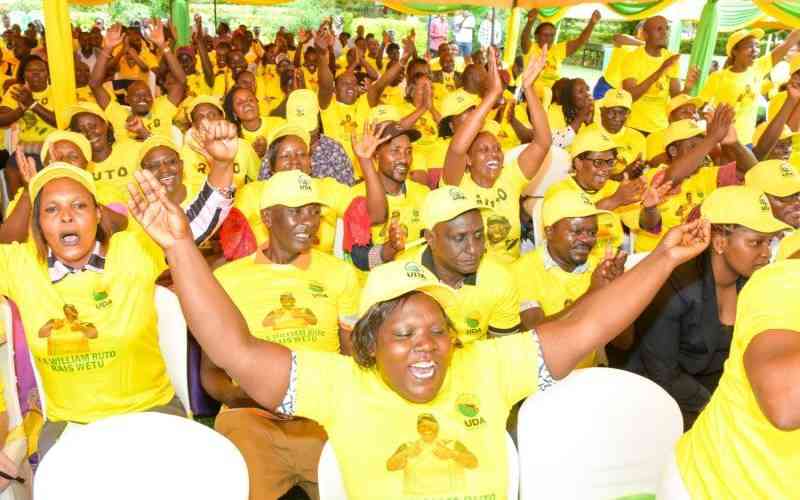Since the advent of multi-party politics in the early 1990s within the Kenyan governance spectrum, significant democratic dividends have been realized. This is ostensibly the positive side of the Kenyan multi-parties continuum which most ‘forward-thinking’ politicians and political activists often refer to. This is rather a subjective reference and perspective.
In incorporating a substance and touch of objectivity, it is fundamental to note that indeed the principle of multi-parties has to a greater extent contributed to the ethnic polarization of the Kenyan state. Multi-parties have been a ground on which the divergence of nationhood has taken place rather than the initial perceived convergence that it was touted to generate.
Way back before the repealing of the infamous Section 2A of the Constitution, Kenya was largely peaceful with very low levels of ethnic hatred, animosity and enmity a fact that is partly attributed to having a one party rule system. After the 1990/91 period of time the political narrative changed and so did the script on nationhood.
Two decades later following the re-introduction of multi-party politics, the dream of nationhood is generating into a nightmare as the political parties are formed and structured on the basis of the ethnic orientation. Perhaps the only exception to this was when the Forum for the Restoration of Democracy (FORD) was formed before it disintegrated into several factions that were to later transform themselves into ethnic political shells.
Basing on the extant statistical data, Kenya has experienced more ethnic and/or tribal clashes and hatred between 1991 up to the current period as compared to the years before 1991/92. But how viable and valuable was it then to adopt the multi-party system of politics?
Were the agitators of the Second Liberation opportunistic? Of course this is a fact that cannot be ruled out. In the early 1990s the aid agencies and donors worldwide demanded for political reforms especially in countries that were poor, developing and in desperate need of aid to help resuscitate their crumbling economies. As a conditionality attached to the aid, the affected states were required to do away with the single party political systems and introduce multi-parties.
This geopolitical wave proved successful in a number of countries and the heroes and heroines of the Second Liberation seized this opportunity as they were aware of how tattered the Kenyan economy was. Their calls for reforms included the re-introduction of multi-party politics which was exactly the same issue that the development agencies and donors were advocating for.
The adoption of multi-parties was an accident and it was bound to backfire, not because it would collapse but because of the fear that it would divide the country along ethnic lines, a fact that was really emphasized by the then President, Daniel Moi. Perhaps, like a giraffe as described by Jaramogi Oginga Odinga, the senior Moi foresaw the negative effects of this political dispensation.
The drafters of the current Constitution and other relevant stakeholders could have put a capping on the number of political parties before the operationalization or the subsequent amendment of the Political Parties Act. There is no need in having around one hundred and fifty parties whose ideologies are amorphous. In fact the Constitution (Political Parties Act) ought to have stipulated names of the parties with their number not being more than three. The major problem in Kenya is that people relate democracy with the number of the existing political parties. That the more parties we have, the more democratic we are which is a fallacy.
The current political parties are personal property and this has led to limited internal democracy. This is why national elections for party officials are either abandoned by rival factions or the honchos opt for consensus. National unity will be dimmed as long as the ethnically based parties depend on certain personalities for them to survive. I am very certain that in the near future most of the governors and their respective counties are going to form their own political parties which will dilute the efforts of solidifying the course of national unity.
It’s therefore time to re-think about serious amendments to the Political Parties Act in order to establish political parties that have an appealing national outlook and whose political life will outlive several generations to come.
 The Standard Group Plc is a
multi-media organization with investments in media platforms spanning newspaper
print operations, television, radio broadcasting, digital and online services. The
Standard Group is recognized as a leading multi-media house in Kenya with a key
influence in matters of national and international interest.
The Standard Group Plc is a
multi-media organization with investments in media platforms spanning newspaper
print operations, television, radio broadcasting, digital and online services. The
Standard Group is recognized as a leading multi-media house in Kenya with a key
influence in matters of national and international interest.
 The Standard Group Plc is a
multi-media organization with investments in media platforms spanning newspaper
print operations, television, radio broadcasting, digital and online services. The
Standard Group is recognized as a leading multi-media house in Kenya with a key
influence in matters of national and international interest.
The Standard Group Plc is a
multi-media organization with investments in media platforms spanning newspaper
print operations, television, radio broadcasting, digital and online services. The
Standard Group is recognized as a leading multi-media house in Kenya with a key
influence in matters of national and international interest.









